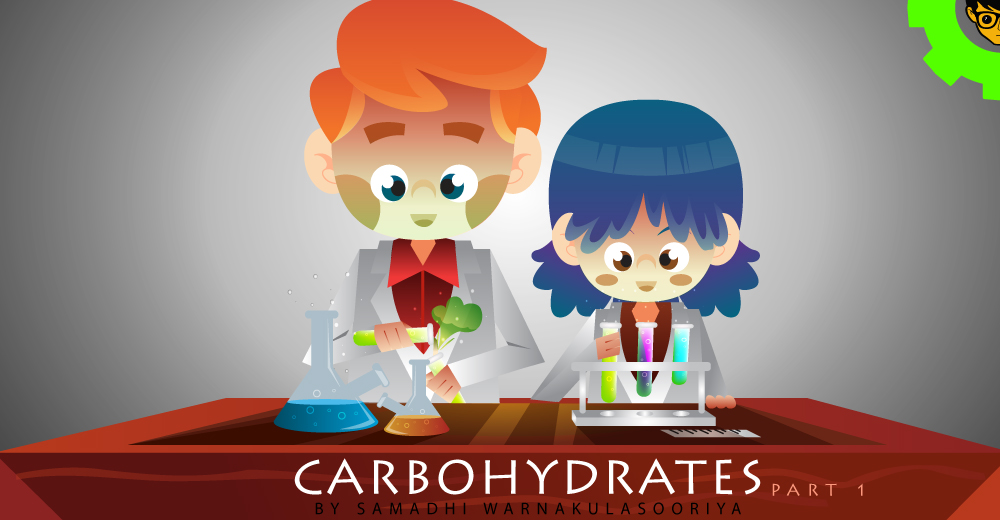
Carbohydrates are the most common group of organic compound in the world with the elemental composition of Carbon, Hydrogen and Oxygen.
Hydrogen to Oxygen ratio is 2: 1 and Cx(H2O)Y is the general formula of carbohydrates. Carbohydrates are found in variety of foods both healthy and unhealthy. However, Carbohydrates are an important part of a healthy balanced diet. Carbohydrates are the main source of energy which supports body functions and physical activities in our day today lives. Carbohydrates can be classified basically into three groups as monosaccharides, disaccharides and polysaccharides. Saccharide is a synonym for a group which includes sugars, starch and cellulose.
1. Monosaccharides
This is the simplest group of carbohydrates which is the composite of a single sugar unit. The general formula of monosaccharides is CnH2nOn. Monosaccharides can be classified further by considering the functional group and the number of carbon atoms in the molecule. When the active group/functional group is an aldehyde group (CHO) the sugar is called as an Aldose. Whereas, the active group/functional group is a ketone, the sugar is called as a Ketose (>C=O). Aldoses are relatively more common than ketoses.
|
Classification of monosaccharides according to the no.of carbon atoms |
Molecular formula |
Aldose |
Ketose |
|
(C3) Triose |
C3H6O3 |
Glyceraldehyde |
Dihydroxyacetone |
|
(C4) Tetrose |
C4H8O4 |
Erythrose |
Erythrulose |
|
(C5) Pentose |
C5H10O5 |
Ribose, Deoxyribose |
Ribulose |
|
(C6) Hexose |
C6H12O6 |
Glucose, Galactose, Mannose |
Fructose |
|
(C7) Heptose |
C7H14O7 |
Heptulose, Glucoheptose, Galactoheptose |
Sodoheptulose |
The commonest group of monosaccharide is Hexose whereas, commonest hexose is glucose. Glucose, galactose and fructose have the same molecular formula but different structural configurations of atoms. So they are called the ‘Isomers’. According to the isomerism, there are two forms as D-form and L-form. Usually D-forms of monosaccharides are predominant in nature.
2. Disaccharides
A disaccharide molecule is the composite of two monosaccharide molecules linked by a glycosidic bond. In here, two molecules of monosaccharides are combined by releasing a water molecule, so this type of reactions is called the condensation reactions.
Disaccharides can be broken down in to monosaccharides liberating a water molecule by using specific enzymes or by adding dilute acid. This reaction is called hydrolysis. There are three types of common disaccharides as Maltose, Lactose and Sucrose.
Maltose is made up of two glucose units and is commonly found in the endosperm of the germinating seeds. The production of maltose depends on the hydrolysis of starch which is the storage food in seeds. The starch is hydrolyzed into maltose by amylase enzyme whereas the maltose is broken down to glucose by maltase enzyme. Maltose is a respiratory substrate, so that maltose is used by the growing embryo and it serves as an energy source.
Lactose consists of one galactose molecule and one glucose molecule and it is commonly known as milk sugar as it is present in the animal milk. It serves as an energy source for mammals. As well lactose is secreted by archegonium of the lower plant and some bacteria also synthesize lactose.
Sucrose consists of one glucose molecule and one fructose molecule. Sucrose is the transport food in plants. It is the most suitable food to be transported as it’s metabolically inactive and highly water soluble. Sucrose is stored in some plants such as sugar cane and beet root.
3. Polysaccharides
Polysaccharides are the composite of large number of monosaccharides which are linked together by glycosidic bonds. Polysaccharides are polymers so they are macro molecules. Macro molecules are high molecular weight molecules with repeating unit called monomer. Hydrolysis of polysaccharides gives monosaccharides or oligosaccharides (a saccharide compost of fewer number of monosaccharides) Polysaccharides are either stored or used to form cellular structures in living bodies. So that polysaccharides can be categorized as storage polysaccharides and structural polysaccharides.
?
- Storage Polysaccharides
Starch, is a polymer of glucose. This is the main storage food in plants and green algae. Two types of glucose chains can be identified in the starch structure as Amylose and Amylopectin. Unbranched glucose chains are known as amylose while the branched glucose chains are known as amylopectin.
Glycogen is a polymer of glucose with amylopectin glucose chains. Glycogen is the main storage food in animals, fungi and protozoans. Glycogen is converted in to glucose and used as an energy source. Normal blood glucose level of a healthy adult is 80-120 mg/dl. When blood glucose level increases than the normal level (hyperglycemia) it is converted in to glycogen and stored in hepatocytes (liver cells) and in mayocytes (muscle cells).This is stimulated by Insulin hormone which is secreted by the beta cells of pancreas. When the blood glucose level decreases than the normal level (hypoglycemia) glycogen is hydrolyzed to glucose and release to the blood stream. This is stimulated by Glucagon hormone which is secreted by alpha cells of the pancreas.Polysaccharides are appropriate storage molecules for several reasons such as less water solubility, can be folded in to compact shapes and can be easily converted into sugar by hydrolysis when required.
- Structural Polysaccharides
Cellulose is the main constituent of cell walls of plants and green algae which is a polymer of glucose. Cellulose usually represents the indigestible part of our food such as fibers which prevents constipation.
Hemicellulose is also a structural polysaccharide which is present as a constituent of cell wall and stored in some seeds such as Dates.
Pectin is a polymer of galacturonic acid which is present in the middle lamella of plant cell wall is a derivative of polysaccharides. It is usually present in the form of Calcium pectate and Magnesium pectate. Pectin hydrolyzed by enzyme pectinase resulting in loosening of plant tissue specially during the ripening of fruits.
?
Murein is a nitrogen containing polysaccharide which is present in the bacterial cell wall.
Physical properties of monosaccharides, disaccharides and polysaccharides
- All the monosaccharides and disaccharides are water soluble whereas polysaccharides are water insoluble.
- All the monosaccharides and disaccharides are crystallisable while the polysaccharides are non-crystallisable.
- All the monosaccharidesa and some disaccharides such as maltose, lactose is reducing sugars while sucrose is a non-reducing sugar.
- All the monosaccharides and disaccharides are sugars except polysaccharides.




